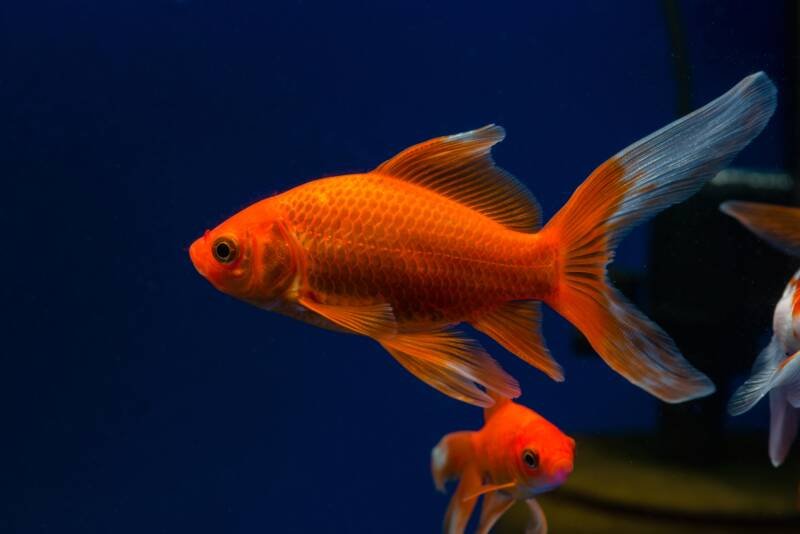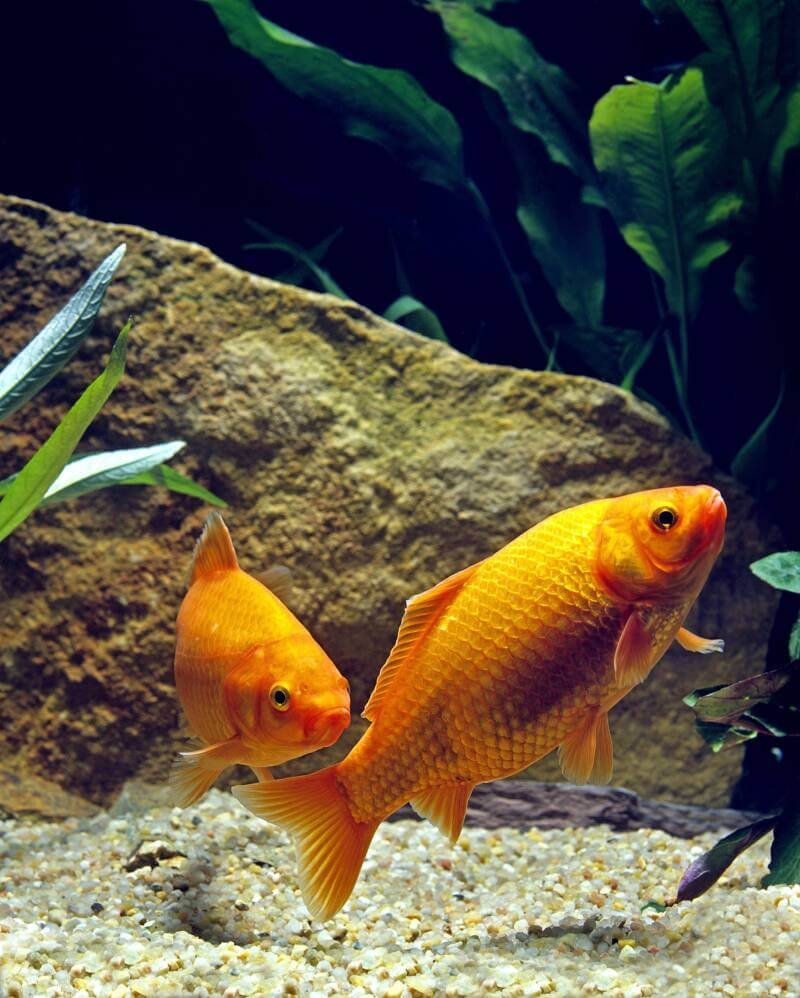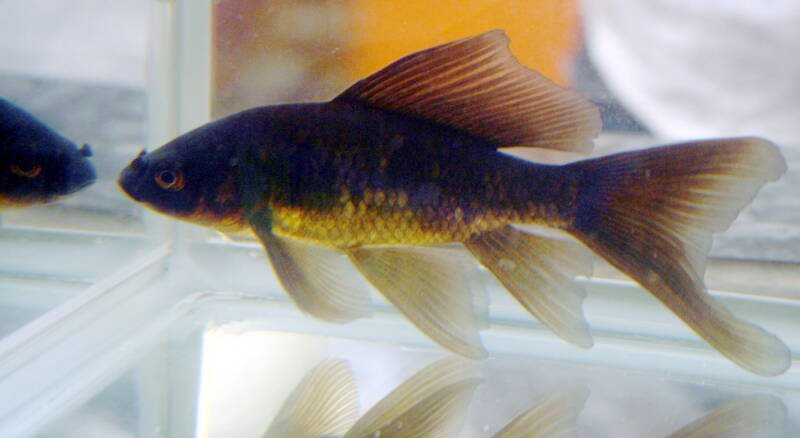People adore comet goldfish. They’re simple to manage and look attractive in aquariums and ponds.
And if you want to consider something a little different from the average goldfish, you’ve probably considered the comet goldfish (Carassius auratus).
At first glance, comets look similar to common goldfish. They both belong to the single-tail group. But comets come in on the smaller size.
And when you look at their tails, you find a deep fork and long, flowing fins that trail behind the comet – a little like their namesake. The same flowing trait appears in their pectoral fins.
And their dorsal fin is more prominent than you’ll find in a common. It allows aquarists to get a more dramatic fish from their “average” goldfish. Which CAN mean some challenges in management.
But if you’re up to the task? You couldn’t ask for a better colorful freshwater fish. Comets have personalities that make them popular with anyone they encounter.
And as long as you’re ready to spend more for their environment and upkeep, they’re available to anyone.


At a Glance
| Tank Size: | 75 gallons (284 l) for one, 50 gallons (189 l) for each additional goldfish |
| School Size: | 5 or more |
| Temperature: | 50-75°F (10-24°C) |
| Lifespan: | 10-20 years |
| Size: | up to 12 inches (30 cm) |
| pH: | 6.0-8.0 |
| Hardness: | 5-19 dH |
| Ammonia: | 0 ppm |
| Nitrite: | 0 ppm |
| Nitrate: | 0 ppm |
In this article
In the Wild
Unlike some of the more dramatic fancy goldfish – which won’t stand a chance of survival in a natural habitat – comet goldfish are a more “recent” breed.
And while they’re still not suited to life in lakes and rivers with those flowing fins, they’re closer to their parent species.
In 1878, the U.S. Fish Commission began importing fish to add to ponds around the Washington Mall. Some of those fish included goldfish.
The Commission wanted to encourage people to start keeping fish as a hobby, so they also gave away thousands of fish.
Hugo Mulertt was one of the government workers that helped with the program. He started a breeding program with some of the goldfish, leading to the comet variety that everyone recognizes today. It’s why they’re referred to as American goldfish.
Comets come in self-colored (a single shade) or bi-colored versions.
The most popular bi-colored option is the Sarasa comet. They’re white with patches of vibrant red.

Some people may mistake them for koi fish, though koi are typically larger and don’t have those trailing fins.
Self-colored comets tend to come in shades of red, orange, yellow, and white.

You may also see rare options of green, “chocolate” (brown), or black. Technically, the black varieties are hybrids of a comet and a koi, though.

All comet goldfish have metallic scales. If you a fish with a similar profile but nacreous or clouded scales, then you’re seeing a Shubunkin goldfish. They share a similar ancestor and breeding line, but they’re not the same variety.
Size
As with many single-tail goldfish, comets have growth-inhibiting hormones. This prevents them from overgrowing their living environment.
And it’s what leads to the myth that you can keep a goldfish in a bowl or vase without a problem.
However, if given a proper living space – such as a pond – comet goldfish usually reach 12 inches (30 cm) in length.
It’s a slow process, though. They undergo a fast burst during the first few weeks of life, and then it backs off. The fish don’t reach full size until they’re 3-4 years old.
Lifespan
In general, all goldfish are hardy. If you take proper care of them and provide a healthy environment, you can expect to see them survive anywhere from 10 to 20 years. On average, comets will live around 14 years.
But you may be surprised. Aquarists that invest time and care in their pond systems – or aquariums – have found their comets surviving for extended periods.
Currently, the record goes to a comet goldfish that survived for FORTY-THREE years!
Behavior
Comet goldfish have long, flowing tails and pectoral fins. Neither impedes their swimming ability, though!
They happily zip around the water column at top speed. Similar to other goldfish varieties, they’re interested in exploring their homes.
And don’t let anyone convince you there’s nothing at work in those fishy brains. Comets have demonstrated the ability to retain a memory of their surroundings – and those who care for them.
Many aquarists rearrange their tanks as a simple way to provide enrichment for their fish. Or you can cope with the fact they’ll decide to redecorate themselves.
True to goldfish fashion, they like to forage in the substrate. Some may even pick up and swim around with pebbles or pieces of gravel in their mouths.
Comets are social fish. You’ll want to keep at least five in your shoal.
But due to their swimming speed and aggressive feeding habits, that can pose a challenge. To prevent anyone from starving, you may want to set up multiple feeding spots so they don’t start shoving one another around.
Tank Setup
Tank size is one of the biggest problems when it comes to keeping comet goldfish. They have long fins, AND they like plenty of swimming space.
A single fish needs at least 50 gallons (189 l), though 75 gallons (284 l) would be better.
If you’re planning to keep a proper school? Your best bet is to look into setting up a pond. It’ll provide the most room for the fish to swim and explore. And it won’t take up an entire room in your home with the necessary equipment.
Because comets are still goldfish, they need a strong filtration system to keep up with all of the waste they produce. Canister filters work best.
Or, if you opt for a pond, sump filters are the ultimate choice. Sump filters behave the same way a natural pond will.
You’ll also want to have air stones handy. Goldfish CAN handle lower oxygen levels, but they’ll survive longer if you offer supplementation.
And if you skip the pond and go with a tank? Invest in a lid because comets WILL jump.
Water Conditions
Comet goldfish aren’t as delicate as fancy goldfish varieties with similar flowing fins, such as the Ranchu.
However, you still want to prevent dramatic shifts in water quality if you want to see your fish reach those impressive lifespans.
They’re not tropical species. This allows them to thrive in ponds without a problem.
Their ideal water temperatures should stay around 50-75°F (10-24°C). It’s okay if your pond sees adjustments here and there, as long as you don’t experience sudden cold snaps.
In theory, this means you can get away WITHOUT a heater. The average room air (or outdoor air) is comfortable enough for your comets to stay comfortable. However, if you live in an area that freezes in the winter, you’ll want one on stand-by.
Comets will tolerate a pH level between 6.0-8.0, but their sweet spot is narrower (6.5-7.5). And again, you don’t want to have sudden changes occur.
The same goes for that hardness level of 5-19 dH. So if you know you have massive rainstorms coming? You may want to take precautions.
Decorating the Comet Goldfish Tank or Pond

It’s important to make your comet goldfish feel as comfortable as possible. And a tank or pond that encourages them to explore and stay active works best.
Remember, you can change around the décor without causing them undue stress.
But you want a substrate that won’t damage their tails or fins. Sand, fine gravel, or smooth pebbles work best.
They’re going to root around in the substrate, and they won’t bother to notice that sharp edges cut their fins. That’s your job.
Plants will not only help boost oxygen levels, but they’ll also provide places to hide. This is especially important when your comet goldfish are growing. Ponds often serve as a “buffet” for predators such as feral cats in the neighborhood.
Not to mention that comets like to chew on the foliage. They’re omnivores, but they also like to do so out of habit. So you want plants that can survive the abuse:
- Amazon sword
- Anacharis
- Anubias
- Crypts
- Duckweed
- Hornwort
- Java fern
- Java moss
- Onion plant
- Pothos
- Water sprite.
You want to avoid driftwood or anything else containing tannins. Comet goldfish can’t tolerate tannins the way many tropical species can.
If you decide to add natural caves or pieces of wood, you need to boil them to eliminate the tannins first.
Comet Goldfish in Communities
Comet goldfish are peaceful in temperament. That would suggest they’d make great tank mates for communities.
But they’re not tropically inclined. And they push and shove to get at food. This makes them tricky to pair with other fish. (Tricky but not impossible)
Tank Mates
The best tank mates for comets happen to be other single-tailed goldfish, especially if you’re setting up a pond. You can create an attractive outdoor water feature, complete with koi, commons, Shubunkins, Wakins, and Jikins.
But if you’re looking for something more varied, you’ll need to think through things.
You want fish large enough (or strong enough) to compete for their food. And you need species that can handle cooler temperatures. Some of those fish include:
- Axolotl
- Bristlenose plecostomus
- Dojo loach
- Golden barb
- Guppy
- Rosy barb
- Rubber nose plecostomus
- Weather loach
- White cloud mountain minnow
- Zebra danio.
For those looking to create a mixed-species community, you’re in the clear.
Comets won’t harass apple snails, cherry shrimp, or ghost shrimp. And these invertebrates will help you with some of that waste clean-up.
Incompatible Species
Not every goldfish is compatible with other goldfish varieties. And mixing comets with fancy goldfish never ends well. The poor fancies simply can’t swim fast enough to reach the food in time and end up starving.
You also want to avoid tropical fish. Even if the species has a tolerance for the cooler range of the water temperature or can handle existence in a pond.
The risk of stress or illness breaking out due to that fine line of tolerance is too risky. So skip the following fish:
Food and Diet
Comet goldfish ALWAYS act hungry – even immediately after feeding time. And since they’re omnivores, they aren’t challenging to feed.
It’s knowing WHAT to feed – and when to stop – that can get challenging.
For comets to remain as colorful as possible, you need to vary their diet.
The same thing every day will lead to a dulling of their scales. You’ll want to make sure you alternate between commercial foods, frozen options, live, and even fresh.
Quality proteins will always top a comet’s favorite list. You don’t want to overdo it, though, or they can end up obese. This is a common comet goldfish issue that often shortens their lifespan.
So portion out these comet favorites carefully:
- Bloodworms
- Brine shrimp
- Daphnia
- Mosquito larvae
- Shrimp eggs.
You also want to make sure they get their fruits and vegetables. This can prevent bloating, which is ANOTHER big problem related to goldfish feeding.
You’ll want to turn to lower calorie options to keep them fit and healthy:
- Blueberries
- Broccoli
- Carrots
- Cucumbers
- Lettuce
- Peas
- Strawberries
- Zucchini.
Breeding Comet Goldfish: Prioritize Space
Breeding comet goldfish isn’t necessarily difficult. You need a male and a female.
But you also need PLENTY of room. The parents need their space, but so do the fry. As females can produce up to ONE THOUSAND eggs, you’ll want to check your pond’s dimensions carefully.
Single-tailed goldfish WILL interbreed with one another. So if you’re hoping to stick to comets, you need to make sure you ONLY have comets in your pond. Otherwise, you’re going to end up with hybrids down the road – whether you wanted them or not.
Males or Females?
Unlike some of the rounder fancy goldfish varieties, comet goldfish aren’t as tricky to sex.
They look pretty similar at first glance, but they’ll change when spawning season approaches. It’ll make things easier for you.
When ready to scatter eggs, females grow plumper. If you look down on them (something easy to do with a pond), you’ll notice they have a lopsided appearance. In comparison, the males will look slimmer.
Males will also develop breeding tubercles. The white spots pop up along the pectoral fins and gill covers.
In addition, males start chasing females around the pond. But don’t count on that. Because if you have ONLY males? They’ll also chase each other around.
Separating Parents and Fry
Comet goldfish spawn during the spring. You can wait for this to happen naturally, or you can trigger it yourself. Drop the water temperature to 58°F (14°C) for a month.
Then GRADUALLY increase the temperature to 70°F (21°C) to mimic a warming period.
The male will chase his chosen female around the pond. When he reaches her, he touches her abdomen to encourage her to release her eggs. She usually does this into surrounding plants.
You should leave spawning mops in the tank or pond to make egg removal easier.
Once you confirm the eggs are present, remove them. If you don’t, the adults WILL eat them.
The eggs should stay at 70°F (21°C) for a week. Then they’ll hatch. The fry survive on their egg yolk for several days. Then you can graduate them to infusoria.
Hardiness and Diseases
While most single-tailed goldfish come out on top where health is concerned, you still shouldn’t neglect to pay attention to water quality or proper diet variation.
If you don’t, you may see your comet changing to white or black – and NOT because of ordinary age-related changes.
Fin rot often develops in comets living in unhealthy waters. The bacterial infection attaches itself to their tails or pectoral fins.
As a result, you’ll see your fish looking ragged or frayed. And if the condition persists, pieces of the fin can PEEL OFF!
And out in the open in pond settings, you’ll want to keep an eye out for ich. The protozoan pest can show up whether you forget to keep up with tank maintenance OR pond maintenance. And once it’s in a system, every fish is at risk.
Comet Goldfish: Are They for You?
Comet goldfish are easy to come by. You’ll find them in almost any pet store, fish store, or for sale online.
And at only $1-$3 a fish? You’re not going to end up breaking the bank to stock your pond with a shoal.
Make sure you take a close look at the fish you plan to bring home, though. You shouldn’t see ANY blood in the fins. That’s a sign of poor health. If you attempt to bring such fish home, you MUST quarantine them or risk introducing infection in your tank or pond.
And while comets themselves aren’t expensive, you’ll want to set aside plenty of funds to afford their living environment.
A tank or pond of that size won’t come cheap. But once you see your comets playing around the plants and digging in the sand? It’ll be worth it.
Stocking Your Pond With Color
Comet goldfish enchant people with their trailing tails. And with so many colors available, you can create the perfect pond.
You’ll just need to stay on top of cleaning and feeding. But once you have their living space?
You can relax beside it in quiet contemplation.
Do you keep comet goldfish? How large is your tank (or pond, if you went that direction)?
What’s the biggest obstacle you’ve encountered in your keeping?
Let us know your questions and stories here!